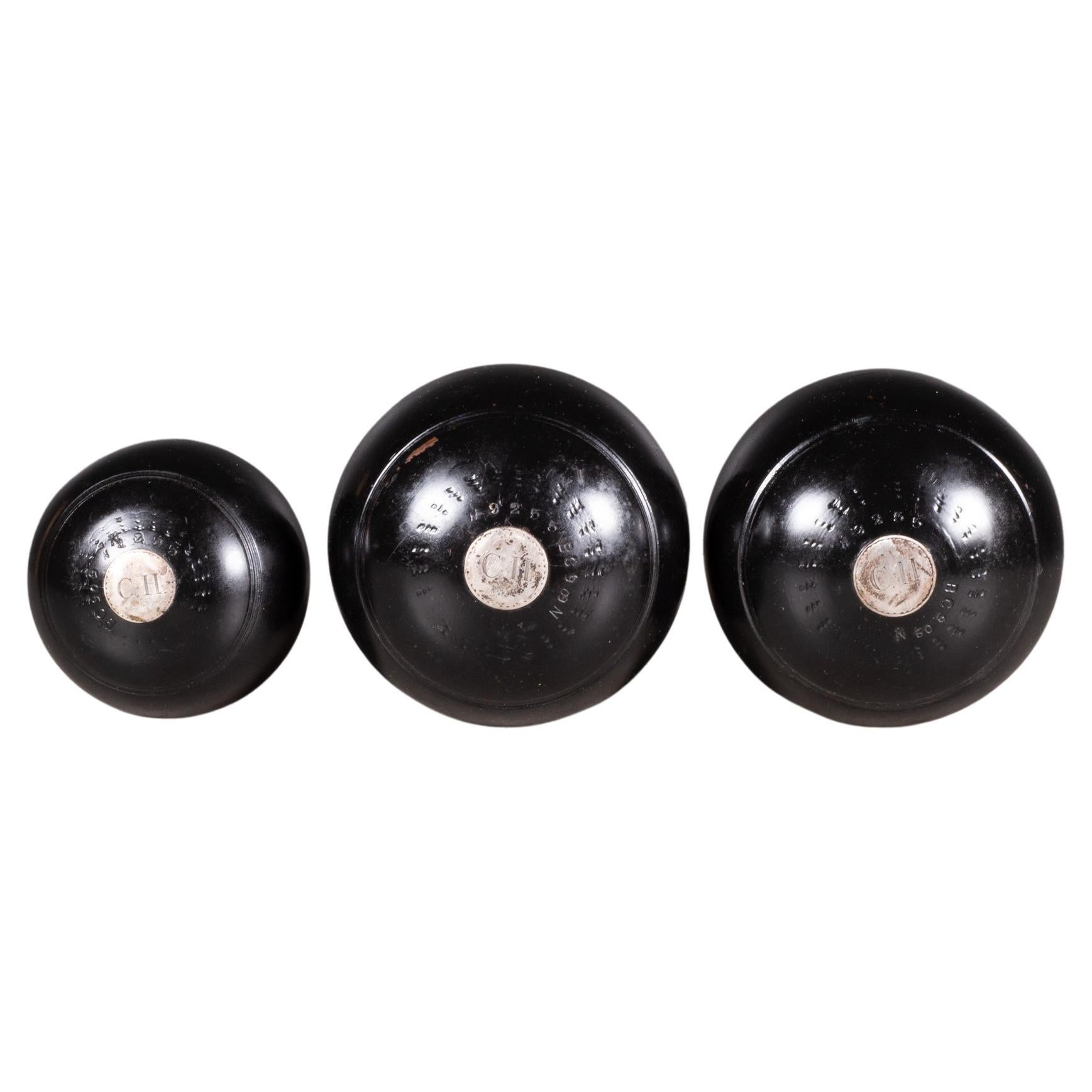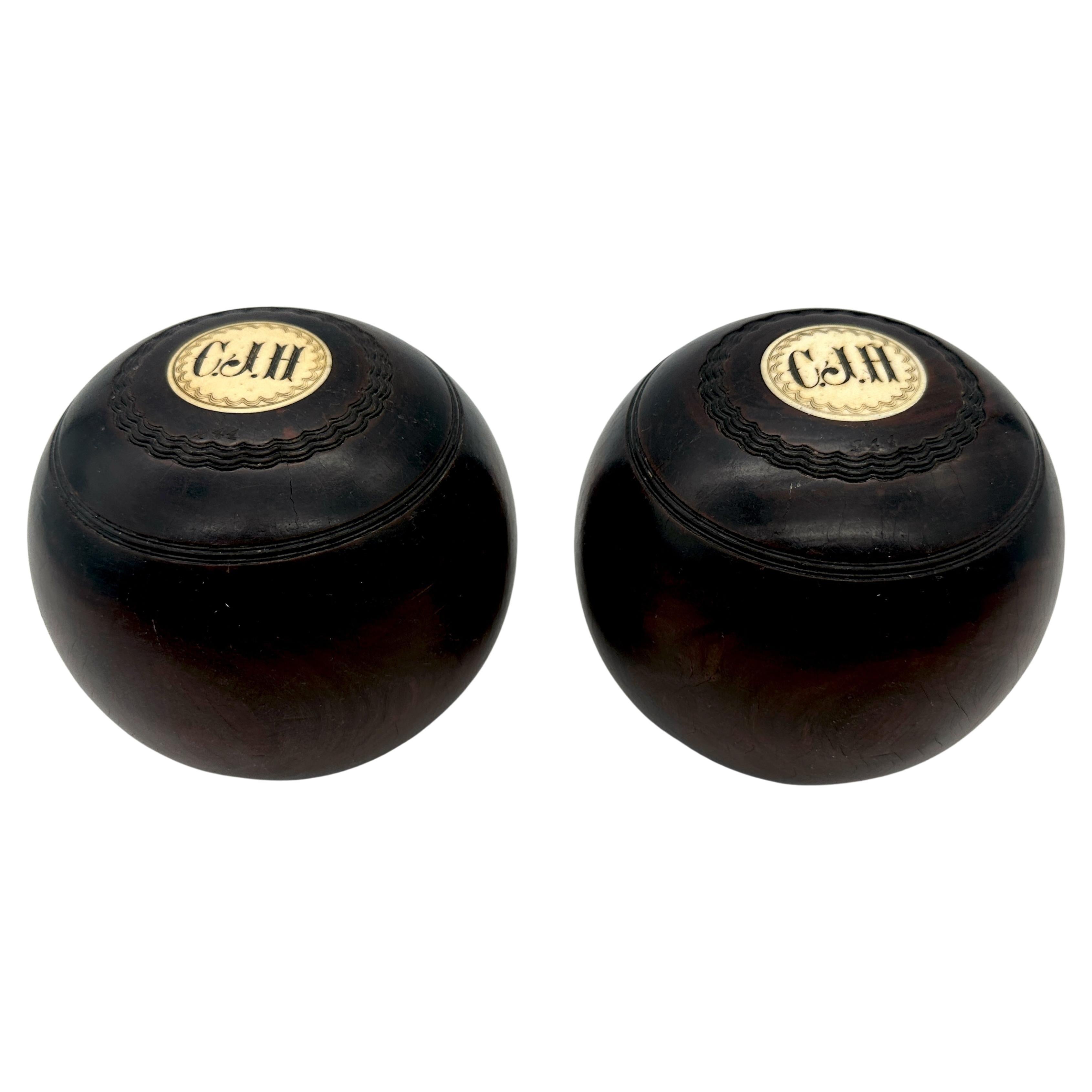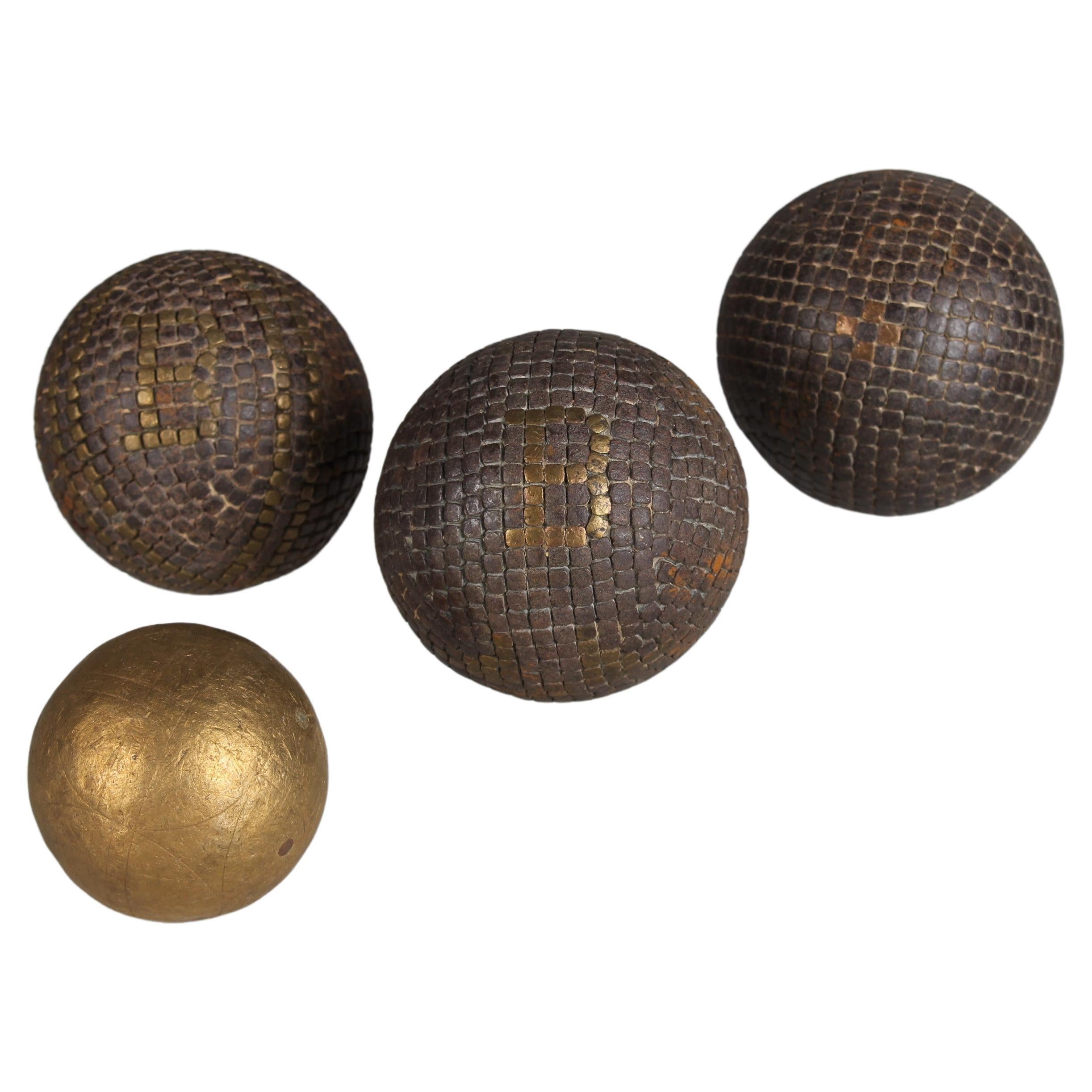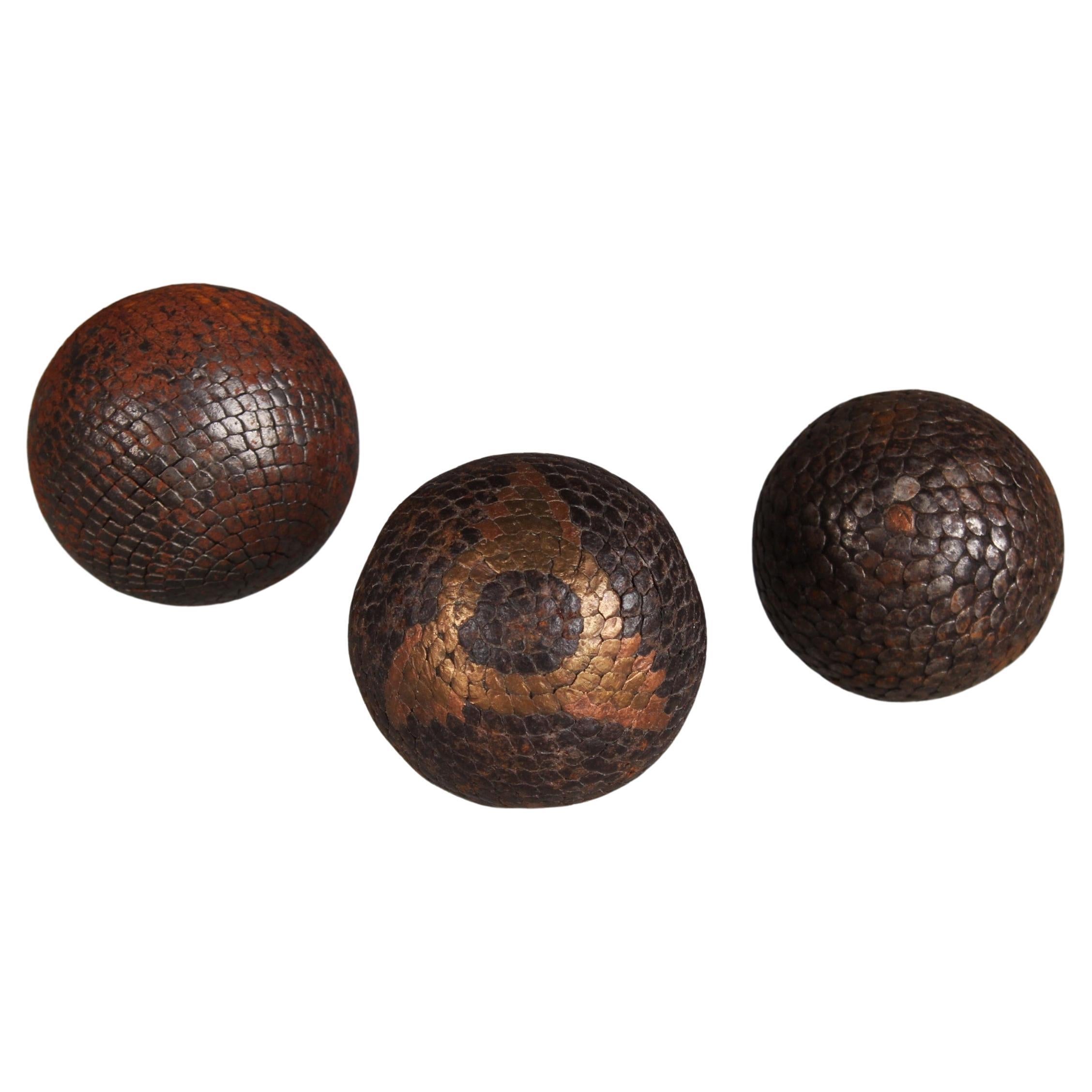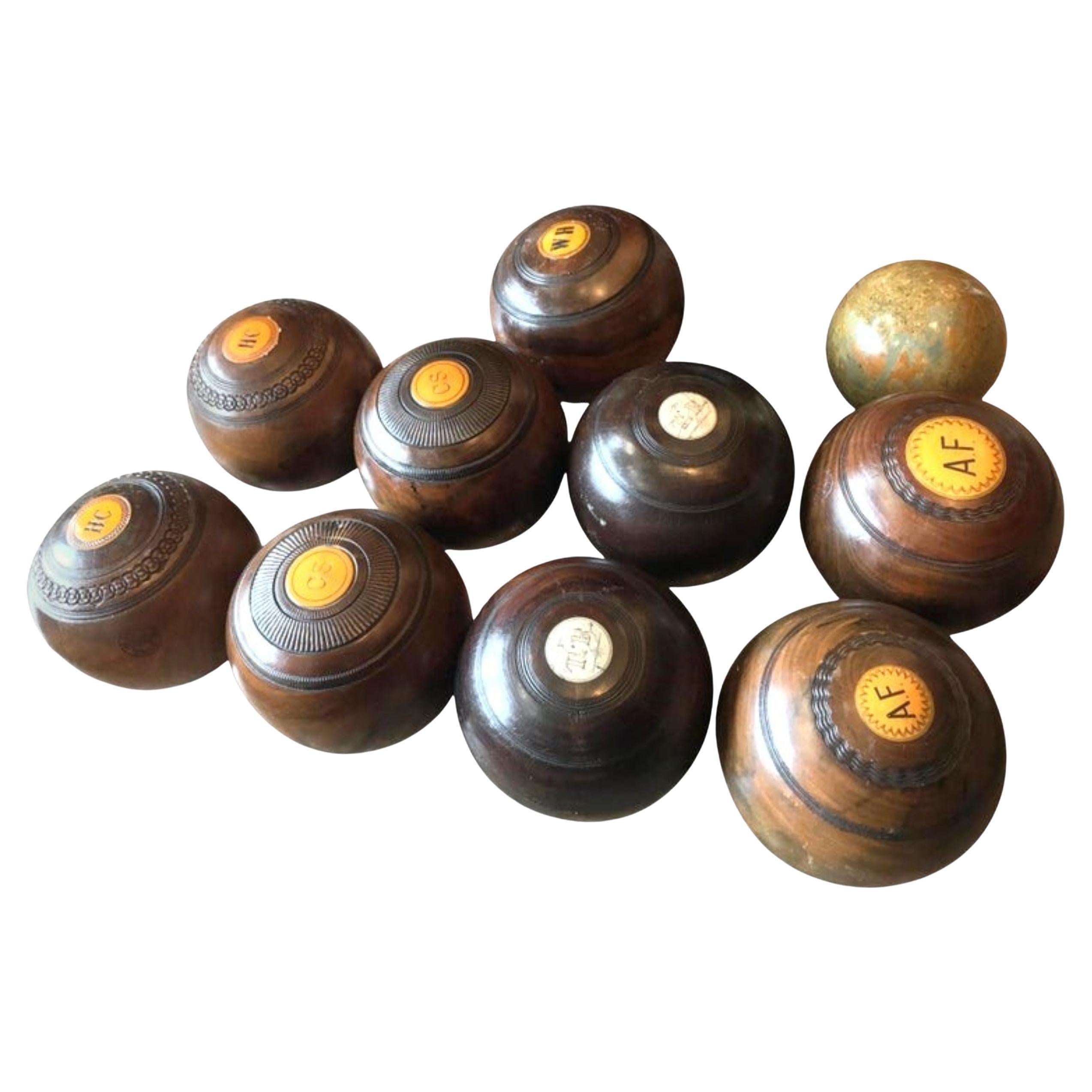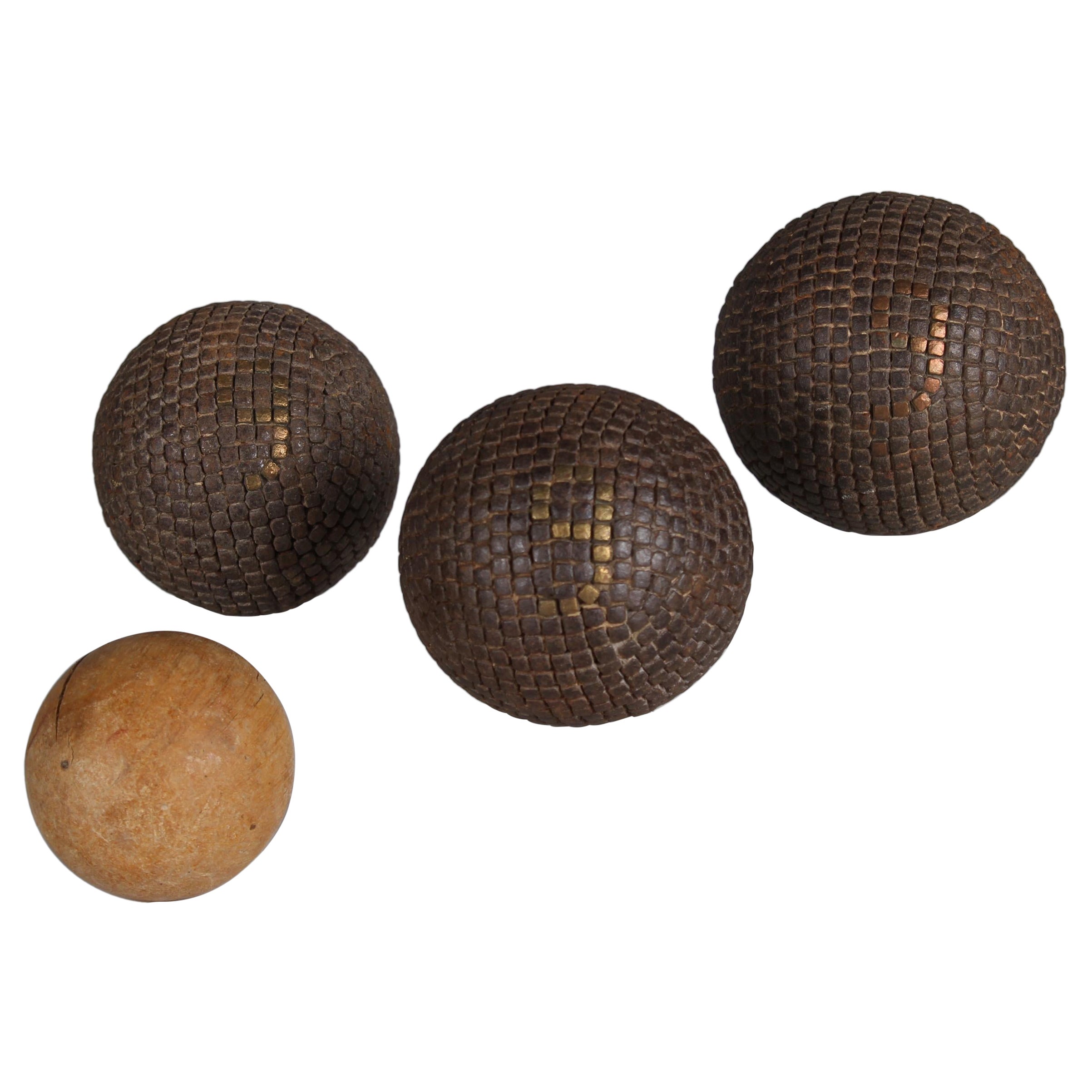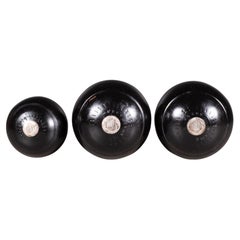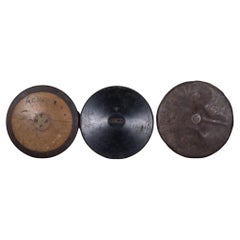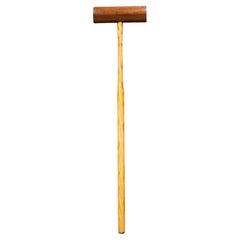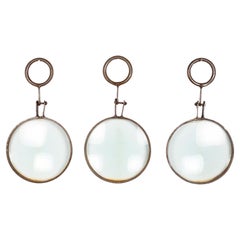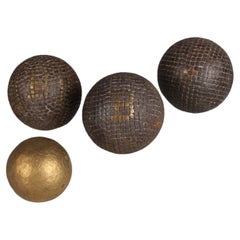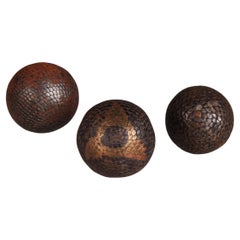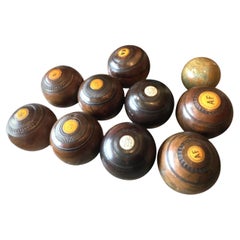Items Similar to Antique Monogrammed Bone Inlaid English Lawn Balls c.1900
Want more images or videos?
Request additional images or videos from the seller
1 of 6
Antique Monogrammed Bone Inlaid English Lawn Balls c.1900
$556per set
$695per set20% Off
£427.71per set
£534.64per set20% Off
€496.45per set
€620.57per set20% Off
CA$784.09per set
CA$980.12per set20% Off
A$878.32per set
A$1,097.89per set20% Off
CHF 461.32per set
CHF 576.65per set20% Off
MX$10,680.04per set
MX$13,350.05per set20% Off
NOK 5,841.86per set
NOK 7,302.32per set20% Off
SEK 5,545.49per set
SEK 6,931.87per set20% Off
DKK 3,705.22per set
DKK 4,631.52per set20% Off
About the Item
ABOUT
A set of English lawn bowls made of Lignum Vitae Wood inlaid with bone. Monogrammed "AJG" and "WPS" and "1" and "2" the other side.
CREATOR Unknown. Made in Scotland.
DATE OF MANUFACTURE c.1900.
MATERIALS AND TECHNIQUES Bone, Lignum Vitae Wood.
CONDITION Good. Wear consistent with age and use.
DIMENSIONS 5 in. x 4.75 in.
HISTORY
Lignum Vitae is the densest and hardest wood known. The trees are indigenous to the Caribbean and the northern coast of South America (e.g., Colombia and Venezuela) and have been an important export crop to Europe since the beginning of the 16th century. The self oiling wood was once very important for applications requiring a material with its extraordinary combination of strength, toughness and density.
- Dimensions:Height: 4.75 in (12.07 cm)Diameter: 5 in (12.7 cm)
- Sold As:Set of 3
- Style:Victorian (Of the Period)
- Materials and Techniques:
- Place of Origin:
- Period:
- Date of Manufacture:1900
- Condition:Wear consistent with age and use.
- Seller Location:San Francisco, CA
- Reference Number:1stDibs: LU1280236374092
About the Seller
5.0
Gold Seller
Premium sellers maintaining a 4.3+ rating and 24-hour response times
Established in 2014
1stDibs seller since 2015
1,319 sales on 1stDibs
Typical response time: <1 hour
- ShippingRetrieving quote...Shipping from: San Francisco, CA
- Return Policy
Authenticity Guarantee
In the unlikely event there’s an issue with an item’s authenticity, contact us within 1 year for a full refund. DetailsMoney-Back Guarantee
If your item is not as described, is damaged in transit, or does not arrive, contact us within 7 days for a full refund. Details24-Hour Cancellation
You have a 24-hour grace period in which to reconsider your purchase, with no questions asked.Vetted Professional Sellers
Our world-class sellers must adhere to strict standards for service and quality, maintaining the integrity of our listings.Price-Match Guarantee
If you find that a seller listed the same item for a lower price elsewhere, we’ll match it.Trusted Global Delivery
Our best-in-class carrier network provides specialized shipping options worldwide, including custom delivery.More From This Seller
View AllAntique Monogrammed Sterling Silver Inlaid English Lawn Balls c.1900 (FREE SHIP)
Located in San Francisco, CA
ABOUT
A set of English lawn bowls made of Lignum Vitae Wood inlaid with sterling silver. Monogrammed "CH" on one side and "T" on the other side.
CREATOR Unknown. Made in Scotla...
Category
Early 20th Century Scottish Victorian Sports Equipment and Memorabilia
Materials
Sterling Silver
$556 Sale Price / set
20% Off
Wood and Metal Throwing Discus circa 1930-1940-ONE LEFT
Located in San Francisco, CA
ABOUT
Wood and metal discus available. The other two have sold.
Antique wood and brass and solid rubber discus. Two are marked "Gill".
CREATOR Gill Sporting Goods Company.
DATE...
Category
Early 20th Century Industrial Sports Equipment and Memorabilia
Materials
Brass, Metal
$96 Sale Price
20% Off
Early 20th c. Walnut and Maple Inlay Croquet Mallet
Located in San Francisco, CA
ABOUT
A vintage Walnut croquet mallet with inlay Maple wood.
CREATOR Unknown.
DATE OF MANUFACTURE c.1920-1950.
MATERIALS AND TECHNIQUES Walnut, Maple.
CONDITION...
Category
Early 20th Century American Industrial Sports Equipment and Memorabilia
Materials
Brass
Set of Cast Iron and Glass Rings c.1940
Located in San Francisco, CA
ABOUT
A set of three cast iron rings with smaller rings on top. Convex glass on both sides in each piece.
CREATOR Unknown.
DATE OF MANUFACTURE c.1940-1960.
MATERIALS AN...
Category
Mid-20th Century Industrial Scientific Instruments
Materials
Iron
Antique Mahogany Sphere Bookends c.1930-1950
Located in San Francisco, CA
ABOUT
Pair of solid Mahogany sphere bookends with original San Juan, Puerto Rico stickers.
CREATOR Unknown. Puerto Rico.
DATE OF MANUFACTURE c.1930-1950.
MATERIALS AND...
Category
Early 20th Century American Art Deco Bookends
Materials
Mahogany
Collection of 19th c. Mortise Marking Guages
Located in San Francisco, CA
ABOUT
Collection of 19th century Rosewood and Boxwood mortise marking gauges with bronze knobs and accents. One is stamped "Pat. Oct. 22, 1872".
CREATOR Unknown.
DATE OF M...
Category
Antique 19th Century Industrial Scientific Instruments
Materials
Bronze
You May Also Like
Pair of 19th Century Scottish Monogramed Hardwood Lawn Balls
Located in West Palm Beach, FL
Pair of 19th Century Scottish Monogrammed Hardwood Lawn Balls
A pair of 19th-century Scottish monogrammed hardwood lawn balls. Each ball, measuring 5 inches in diameter, is crafted...
Category
Antique Late 19th Century Scottish High Victorian Sports Equipment and M...
Materials
Hardwood
$416 Sale Price / set
20% Off
Antique Boule Balls Set "B", Pétanque, 1880s, France, Craftsmanship
Located in Greven, DE
Beautiful, unique Boule set of three Boule balls and one target ball, France, late 19th century.
In the 19th century, the manufacture of boules balls underwent significant development in France as the game of boules, particularly the pétanque variant, gained in popularity. The manufacture of boules balls during this period was a manual process that required expertise, precision and love to detail.
In the late 19th and early 20th centuries, particularly in rural areas of France and other Mediterranean regions, olive wood was a commonly used source of material for making boules balls. This was not only due to the availability of the material, but also to the outstanding properties of olive wood, which was characterized by hardness, strength and a rich grain.
First, the olive wood was carefully selected and shaped into raw balls, which were then sanded to the desired size and shape. The nails were then hammered into the balls one by one, making sure that they were evenly distributed and firmly anchored. Finally, the spheres were polished and coated with a protective varnish to enhance their natural beauty and protect them from the elements.
The use of nails to decorate and reinforce olive wood boules was a traditional practice that not only gave the ball a rustic aesthetic, but also improved its durability and contributed to customization. Many balls were made according to the specific requirements and preferences of the players. Nails were driven at regular intervals around the ball, with each nail hole precisely placed so as not to affect the balance and weight distribution of the ball. These nails not only served as a decorative element, but also helped to strengthen the structure of the ball and make it more resistant to the hard knocks and wear and tear during play. Individual engravings or decorations were often applied to the balls to make them unique and identify the player.
Antique boules...
Category
Antique Late 19th Century French Late Victorian Antiquities
Materials
Olive
Antique Boule Balls Set "B", Pétanque, 1880s, France, Craftsmanship
Located in Greven, DE
Beautiful, unique Boule set of three Boule balls, France, late 19th Century.
In the 19th century, the manufacture of boules balls underwent significant development in France as the game of boules, particularly the pétanque variant, gained in popularity. The manufacture of boules balls during this period was a manual process that required expertise, precision and love to detail.
In the late 19th and early 20th centuries, particularly in rural areas of France and other Mediterranean regions, olive wood was a commonly used source of material for making boules balls. This was not only due to the availability of the material, but also to the outstanding properties of olive wood, which was characterized by hardness, strength and a rich grain.
First, the olive wood was carefully selected and shaped into raw balls, which were then sanded to the desired size and shape. The nails were then hammered into the balls one by one, making sure that they were evenly distributed and firmly anchored. Finally, the spheres were polished and coated with a protective varnish to enhance their natural beauty and protect them from the elements.
The use of nails to decorate and reinforce olive wood boules was a traditional practice that not only gave the ball a rustic aesthetic, but also improved its durability and contributed to customization. Many balls were made according to the specific requirements and preferences of the players. Nails were driven at regular intervals around the ball, with each nail hole precisely placed so as not to affect the balance and weight distribution of the ball. These nails not only served as a decorative element, but also helped to strengthen the structure of the ball and make it more resistant to the hard knocks and wear and tear during play. Individual engravings or decorations were often applied to the balls to make them unique and identify the player.
Antique boules...
Category
Antique Late 19th Century French Late Victorian Antiquities
Materials
Olive
10 Carpet Lawn Bowling Hand Carved Wood & Stone Balls Antique Office Gift Idea
Located in West Hollywood, CA
10 Carpet Lawn bowling hand carved wood & stone balls antique office gift idea. A Beautiful Decorative Antique collection of 9 + 1 boules balls Carved Wood and a Jack Carved Stone ba...
Category
Antique 19th Century Scottish Sculptures and Carvings
Materials
Stone
$4,600 Sale Price / set
22% Off
Antique Boule Balls Set "9", Pétanque, 1880s, France, Craftsmanship
Located in Greven, DE
Beautiful, unique Boule set of three Boule balls and one target ball, France, late 19th century.
In the 19th century, the manufacture of boules balls underwent significant development in France as the game of boules, particularly the pétanque variant, gained in popularity. The manufacture of boules balls during this period was a manual process that required expertise, precision and love to detail.
In the late 19th and early 20th centuries, particularly in rural areas of France and other Mediterranean regions, olive wood was a commonly used source of material for making boules balls. This was not only due to the availability of the material, but also to the outstanding properties of olive wood, which was characterized by hardness, strength and a rich grain.
First, the olive wood was carefully selected and shaped into raw balls, which were then sanded to the desired size and shape. The nails were then hammered into the balls one by one, making sure that they were evenly distributed and firmly anchored. Finally, the spheres were polished and coated with a protective varnish to enhance their natural beauty and protect them from the elements.
The use of nails to decorate and reinforce olive wood boules was a traditional practice that not only gave the ball a rustic aesthetic, but also improved its durability and contributed to customization. Many balls were made according to the specific requirements and preferences of the players. Nails were driven at regular intervals around the ball, with each nail hole precisely placed so as not to affect the balance and weight distribution of the ball. These nails not only served as a decorative element, but also helped to strengthen the structure of the ball and make it more resistant to the hard knocks and wear and tear during play. Individual engravings or decorations were often applied to the balls to make them unique and identify the player.
Antique boules...
Category
Antique Late 19th Century French Late Victorian Antiquities
Materials
Olive
Antique Boule Set, Boule Balls, Pétanque, 1880s, France, Craftsmanship
Located in Greven, DE
Beautiful, unique Boule set of three Boule balls, France, late 19th century.
In the 19th century, antique metal boules balls experienced a renaissance that took the game of boules to a new level.
These ornately crafted balls were not only instruments of the game, but also symbols of elegance and sophistication in leisure activities.
Made from high-quality metals such as steel or brass, Boule balls were forged and polished by skilled craftsmen to ensure a smooth and even surface.
The antique boules...
Category
Antique Late 19th Century French Late Victorian Antiquities
Materials
Metal
More Ways To Browse
Victorian Monogram
English 16th Century Furniture
Lignum Vitae Furniture
Lignum Vitae
Antique Lignum Vitae
Lawn Balls
Antique Lawn Bowls
Leather Gym Equipment
Hickory Golf
Used Fly Reels
Used Toboggans
Victorian Walking Cane
Yankees Collectibles
Bamboo Walking Stick
Horse Racing Memorabilia
Surfboards Hawaii
Vintage Wood Walking Stick
Antique Football Memorabilia
